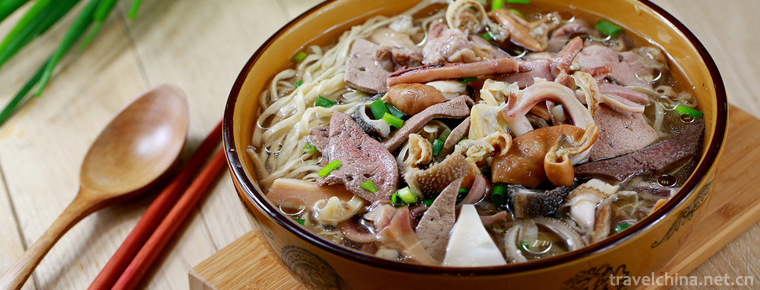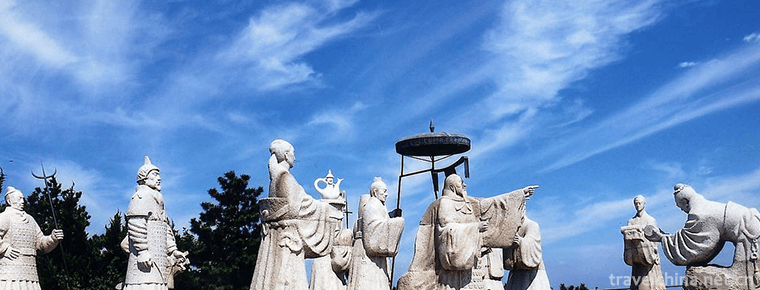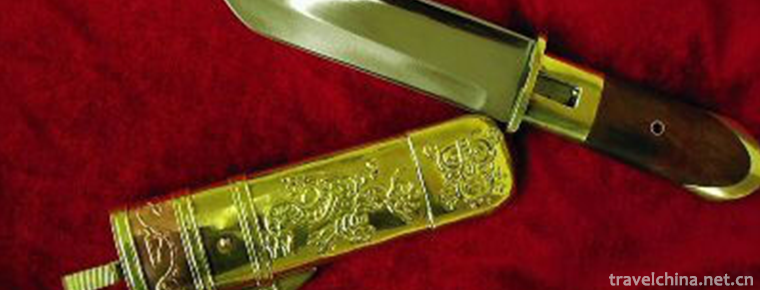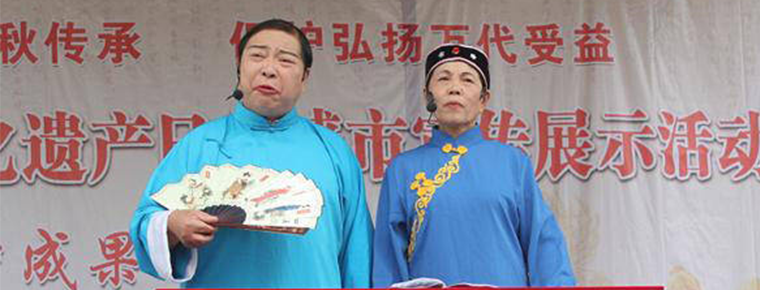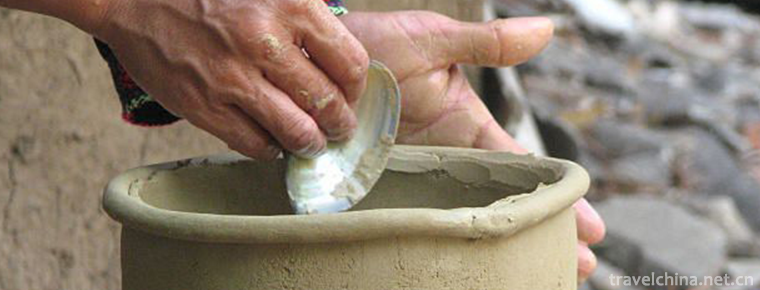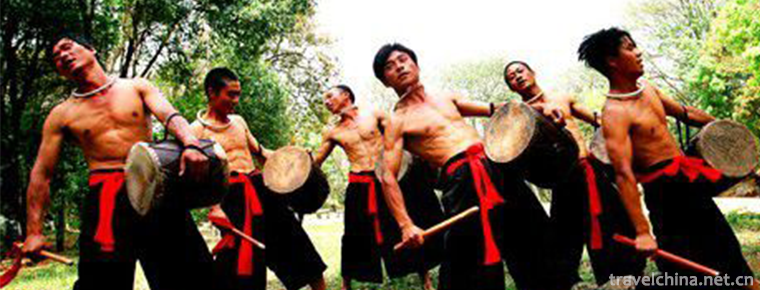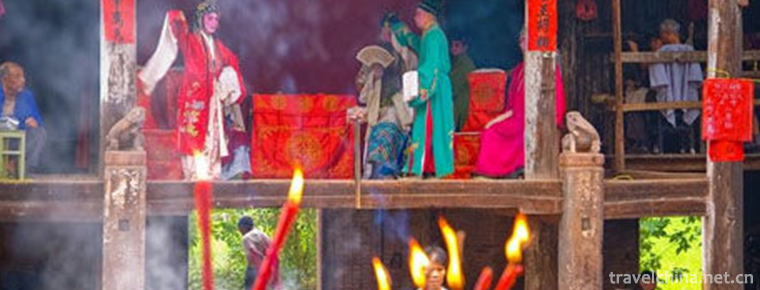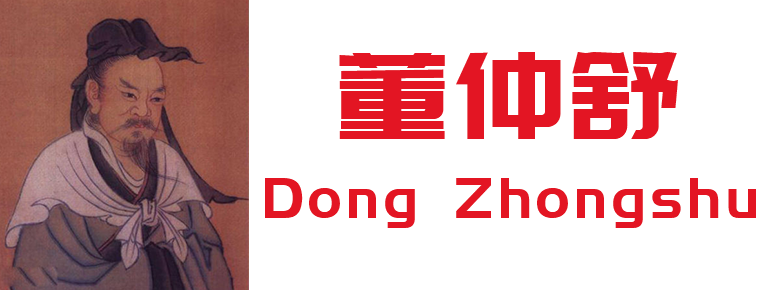Jianglangshan 28du Tourist Area
Jianglangshan 28du Tourist Area
28du Town, located in Jiangshan, Zhejiang Province, is a famous historical and cultural town. It is a writer's creation base in Zhejiang Province. It is located at the junction of Zhejiang, Fujian and Jiangxi provinces. It is an important market town in the border area in history. It is known as "Fengxi Keys". Experts call it "cultural enclave" and scholars call it "a dream left in the mountains".
In 2007, 28 were listed as famous historical and cultural towns in China; in 2008, they were named as the hometown of Chinese folk culture and art (folk songs).
On February 25, 2017, it was newly promoted as a national 5A tourist attraction.
geographical position
Located at the border of Zhejiang, Fujian and Jiangxi provinces, 28du Town has convenient transportation and 205 National Highway passes through the town. The town covers an area of 66.7 square kilometers and has a population of 10876. Compared with the famous ancient towns such as Zhouzhuang, Tongli and Wuzhen, it is still hidden in the mountains. It has a totally different style from those ancient towns in the south of the Yangtze River, even with some mystery. More than 1,100 years ago, Huang Chao went south and opened up an ancient Xianxia Road in the mountains between Zhejiang and Fujian. From then on, the 28 passes around and the mountains surrounded by them have become the places where soldiers and soldiers of all dynasties have to fight for. In the Qing Dynasty, the millennial ancient road with military functions gradually became the main road for business and travel. Ships going up the Qiantang River loaded cloth from Jiangsu and Zhejiang provinces, and daily department stores arrived at the Qinghu pier in Jiangshan to dock. Then they turned to land and were carried by the shoulder of the bearer of the bearer to Fujian and Jiangxi provinces. Local specialties from Fujian and Jiangxi will also be shipped to Qinghu to Jinqu, Shanghai and Hangzhou. As the first stop for the transit of goods in the past, the 28th Capital, a necessary transportation hub, has rapidly become the most prosperous commercial port along the border of the three provinces. In its heyday, shops, restaurants and inns were full of cobblestone streets, day-to-day shoulder-workers, night-to-night businessmen, traveling from south to North every day, bustling and prosperous for hundreds of years.
There are many well-preserved Ming and Qing ancient buildings in the town, which belong to provincial historical and cultural protection areas. In 2007, 28 were listed as famous historical and cultural towns in China; in 2008, they were named as the hometown of Chinese folk culture and art (folk songs). Rich and colorful human landscape, simple and rich folk customs, unique and profound cultural accumulation, make the ancient and elegant 28 Du Town look extraordinary in the surroundings of modern civilization. Many experts, scholars and eminent personages both inside and outside the province have visited 28 capitals. They praise the ancient buildings here and think that they are of great value for historical protection and tourism development.
Introduction to scenic spots
The 28th Capital is 70 kilometers away from Jiangshan City and County Town. It is an old town. The town has more than 800 households and 4000 people. In the four years of Xining in the Northern Song Dynasty (1071), there were forty-four capital cities in Jiangshan. This place ranked twenty-eighth and was named twenty-eighth capital. It has a history of more than 900 years. Because of the scarcity of war in history, the ancient architecture of the town remains intact and well preserved. According to statistics, there are 36 dwellings and halls of ancient Ming and Qing dynasties, including 11 public buildings such as Confucius Temple, Dawang Temple, Wenchang Pavilion, Longevity Palace, Zhenwu Zeus, Zhongyi Temple, Guanyin Pavilion, Laoyamen and Xinxing Society. Among these numerous temples, temples, palaces and palaces, the Dawang Temple is the largest and the Confucian Temple is the most magnificent. Confucius Temple was built in Xuantong period, covering an area of more than 1500 square meters. The overall layout along the central axis is Zhaobi Menting, the main gate, the front hall, the patio, the main hall, the main hall, the main hall, the courtyard, the dormitory, a total of three into the three courtyards, left and right, connected by the eaves corridor, the structure, the Ming Dynasty is a beam-lifting type, side-pasting type, the main hall is a two-storey double eaves Xieshan top pavilion, the four eaves are picked out, very tall and magnificent. The most distinctive feature of the building is the exquisite wood carving art and abundant paintings. All beams, fangs, ridges and ceilings are painted with moon landscapes, character stories, dragons, phoenixes, flowers and birds.
Works, geometric figures, brackets, sparrows, window fans, fences and other wood components have relief or hollow carvings, rich themes, vivid images, like an art treasure house.
At the entrance of Zhennan Village, there is a semi-circular single-hole stone arch bridge over Fengxi River. There are nine bridges and pavilions on the bridge, the middle of which is the top of Zhongyan Xie Mountain. It was built in 1891, the seventeenth year of Guangxu in Qing Dynasty. It is the only ancient bridge with ancient bridges and pavilions in Western Zhejiang.
The ancient residential buildings in the town are not only large in number and well preserved, but also have very different architectural styles from those in other places. Layout is different in terrain, environment and roadways, which are scattered and varied. The basic structure of the dwelling is quadrangular courtyard with rectangular plane, two into one day well and three into two days well. The hall in the house is self-made courtyard. The patterns on the doors and windows are seldom identical. The main station of the dwelling is stone structure. The door building rarely sees brick carving. It is mostly composed of delicate wood carving components. The four columns and three floors of the attic style are unique.
The old town had four City gates, east, west, north and south. Today, only the stone gate in the south of town has one side. The book has the key of Fengxi Lock. A street runs side by side with a stream, winding up to one kilometer from north to south. On both sides are shops and workshops on the second floor, which basically maintained the style of the 19th century market town.
The buildings of 28du Town are built on both sides of the ancient road, which is 1 kilometer long. Shuli Street in the north, mainly residential; Fengxi Street in the south, mainly business. In Tongzhi year of Qing Dynasty, there were more than 50 restaurants and 40 grocery wholesalers. But what is more remarkable is the public buildings such as bridges, temples and pavilions.
Shui'an Bridge, a gallery bridge across the Fengxi River, in the morning fog and sunset, showing different sides, actually murdered many of our film. The people who worked all day and the children who were tired of playing rested on the corridor bridge, which added a little to the beauty of the scenery. Fengxi Bridge is a typical stone arch bridge structure. It forms a tranquil and lyrical Chinese painting with the surrounding Mercury Temple. The rest, such as Huaqiao, leave only place names, and the original bridge structure no longer exists.
The Dawang Temple is the most beautiful one in the sunset, with golden paddy paddy paddy paddy paddy paddy paddy paddy paddy paddy paddy paddy paddy paddy paddy paddy paddy paddy paddy paddy paddy paddy paddy paddy paddy paddy paddy paddy paddy paddy paddy paddy paddy paddy paddy paddy paddy paddy paddy Padd
There are two Wenchang Pavilions, big Wenchang Pavilion in the north of town and small Wenchang Pavilion in the south of town. The magnificence and delicacy of the two buildings are unparalleled in the local area. Wenchang Pavilion is generally only a county government, where the emperor Wenchang and Quixing are worshipped. Although 28du people become rich by doing business, they are still unable to get rid of the complex of "learning while excelling in official affairs". Their wishes and dreams have already flown out of the mountains to the distant Kyoto. At the same time, they also left more than 300 paintings among the beams, fangs and algae wells of Dawenchang Pavilion, and encouraged their descendants with "hanging beams and spining stocks" and "returning clothes and brocades to their homeland".
Cao, Jiang, Yang and Jin are the big families in the ancient town. They live around their clans, and there are still 36 complete ancient residential courtyards. Standing on the old street, the most distinctive feature is the lintel of every household. The lintels are mostly castle-like, consisting of beams, fangs, eaves, watchboards and suspended curtain virtual columns. Each part has delicate woodcarving decoration, and the theme is mostly mascots such as Fu Lushou, He He Erxian. The wooden lintel is in sharp contrast to the brick doors in other parts of the Yangtze River, which makes people walk on the old street and be attracted by the scenery. Looking at the Hui-style Horsehead wall, Zhejiang-style roof, Gan-style eaves citron, Fujian-style earth wall, its rich connotation has been enough to make architects amazed.
Train
2185: Hangzhou - Nanchang 19:25 - Jiangshan 00:33
1325: Hangzhou - Chongqing 20:17 - Jiangshan 00:47
Bus: Hangzhou South or West Bus Station has express passengers to Jiangshan around 8 a.m., arriving in 4 hours or Quzhou first at West Bus Station. The bus from Quzhou to Jiangshan runs for 10 minutes and 40 minutes.
Self-driving
Hangzhou Direction: Shanghai-Hangzhou Expressway - Hangzhou Jinqu Expressway - Jingtai Expressway - 28du Export, if directly to the scenic spot Jingtai Expressway Jianglangshan Export.
Wenzhou Direction: Jinliwen Expressway - - Lilong Expressway (Lishui to Longquan) - - Longli Expressway (Longyou - Lishui) - - Hangzhou Jinqu Expressway - - Jingtai Expressway - - - 28du Export, if directly to the scenic spot Jingtai Expressway Jianglangshan Export.
Fuzhou Direction: Jingtai Expressway (Huangqunan) - - Exports from 28 cities, such as Jianglangshan, a scenic spot.
The specific time for Jiangshan to 28du buses is:
{5:40} {6:25} {7:10} {7:55} {8:40} {9:55} {11:20} {12:30} {13:10} {13:50} {14:20} {15:00} {15:30} {16:40}
Shopping
Twenty-eight capes can also be used as raincoats.
The 28du Cake Cake is smooth and refreshing, with a blend of Passion and comprehensive nutrition.
Ticket information
Ticket Type, Market Price, Network Price
Adult votes 75 65
Ticket Purchase Notes
1. Opening hours of scenic spots: 8:00-17:00
2. Ticket Collection Place: Ticket Office of Scenic Spot
3. Reservation criteria for special population:
A. Free Policy: Tour guides, active servicemen, revolutionary disabled soldiers, family members of martyrs, journalists and the elderly over 70 years old can be exempted from tickets by valid documents. B. Preferential policies: children 1.2-1.5 meters tall; disabled persons with valid certificates; elderly people aged 60-70 years old, primary and secondary school students with valid certificates to buy tickets at a half price of 38 yuan per person. Other preferences are subject to the announcement of scenic spots.
4. Invoice Note: No invoice is provided for online booking of tickets for scenic spots.
5. Warm Tip: The combined ticket for the scenic spot of Floating Cover Cave Group does not include the transportation fare from 28 metres to 10 yuan per person; all the combined tickets do not belong to the preferential ticket category.






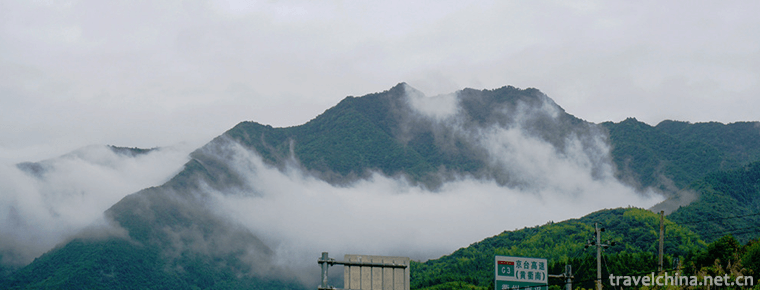
-
Pig liver Noodles
made from noodles, pig bones, fresh pig liver and other main ingredients.
Views: 258 Time 2018-10-12 -
Langyatai Scenic Area
Langyatai Scenic Spot belongs to Qingdao Langyatai Provincial Tourism Resort (established in December 1995 with the approval of Shandong Provincial People's Government with a planned area of 9.8 squar.
Views: 181 Time 2019-01-29 -
Baoan Waist Knife Forging Techniques
Baoan waist knife forging technology, Gansu Province Jishishan Baoan Sala Autonomous County traditional handicraft, one of the national intangible cultural heritage..
Views: 160 Time 2019-04-04 -
Gell
"Gar", which means singing and dancing in Tibetan, also means "music and dance", because performing Gar has accompaniment of special instruments. On the staff roster of the Tibetan.
Views: 316 Time 2019-04-30 -
Hanchuan good books
Hanchuan Shanshu is a kind of traditional folk music which combines rap and singing in Hubei Province. Since the Qianlong period of the Qing Dynasty, it has a history of 260 years. .
Views: 126 Time 2019-05-02 -
Primitive Pottery Making Skills of Li Nationality
The primitive pottery making technique of Li nationality, the traditional handicraft technique of Changjiang Li Autonomous County, Hainan Province, is one of the national intangible cultural heritages.
Views: 181 Time 2019-05-13 -
Drum dance
Hani rhythm and drum dance is a kind of sacrificial dance of Hani people on the traditional festival "Onmatu". The dance is vigorous and bold, vigorous, simple and free, showing the same per.
Views: 52 Time 2019-05-23 -
Qiyang Opera
Qi Opera is one of the traditional local dramas in Hunan Province. It is also called Qiyang Band, Qiyang Opera in the early years of the Republic of China, and Qiyang Qidong Opera in the folk.
Views: 94 Time 2019-06-10 -
Traditional craftsmanship of moon cakes
Guo Dulin Jin-style moon cakes are Shanxi specialty. They are simple in shape, mellow in taste, crisp and refreshing, sweet but not greasy. They are famous for their crispness, delicacy, sweetness, me.
Views: 192 Time 2019-07-16 -
Dong Zhongshu
Dong Zhongshu (179 BC - 104 years ago), Guang Chuan (Hebei Jingxian County southwest, Jingxian County, Gucheng, Zaoqiang three counties junction) people, the Western Han Dynasty. philosopher emperor j.
Views: 112 Time 2019-09-07 -
Overview of Guangyuan
In 2019, the GDP of Guangyuan will reach 94.185 billion yuan, an increase of 7.5% over the previous year, which is the same as that of the whole province. Among them, the added value of the primary industry was 15.301 billion yuan, an increase.
Views: 349 Time 2020-12-15 -
Education in Yibin
In 2019, there will be 11000 students enrolled, 50900 students and 13600 graduates. There are 4 graduate training units, 393 graduate students, 918 students and 68 graduates. There are 17000 students in adult colleges and universities. 43500 pe.
Views: 239 Time 2020-12-18
